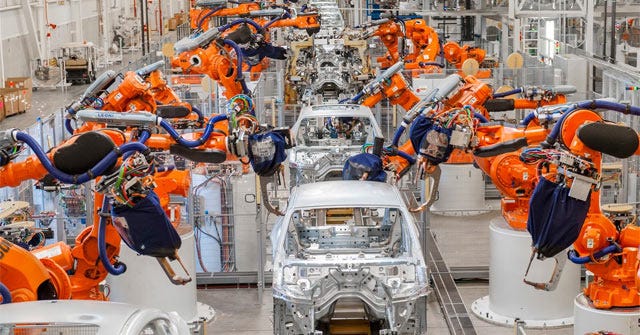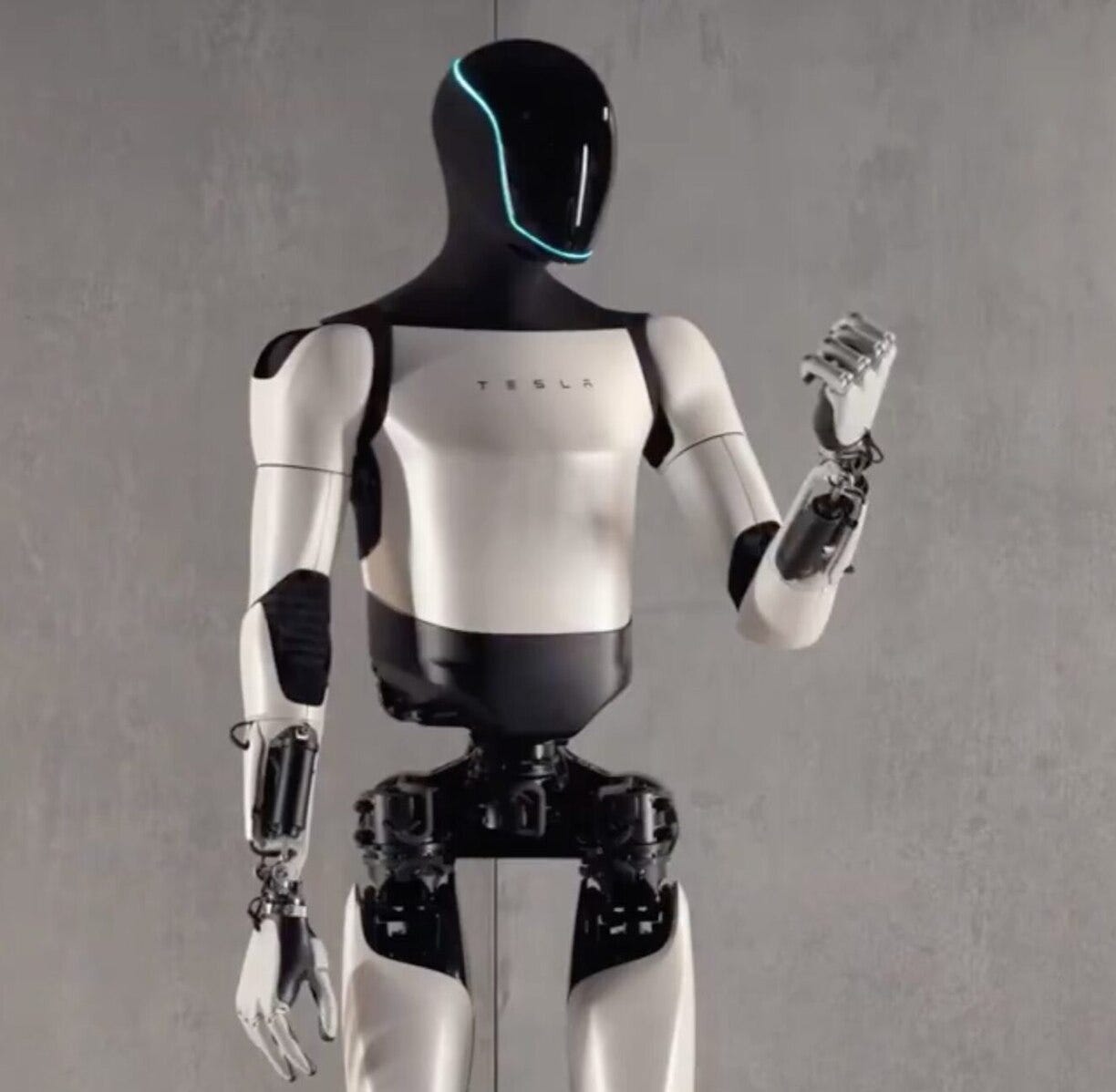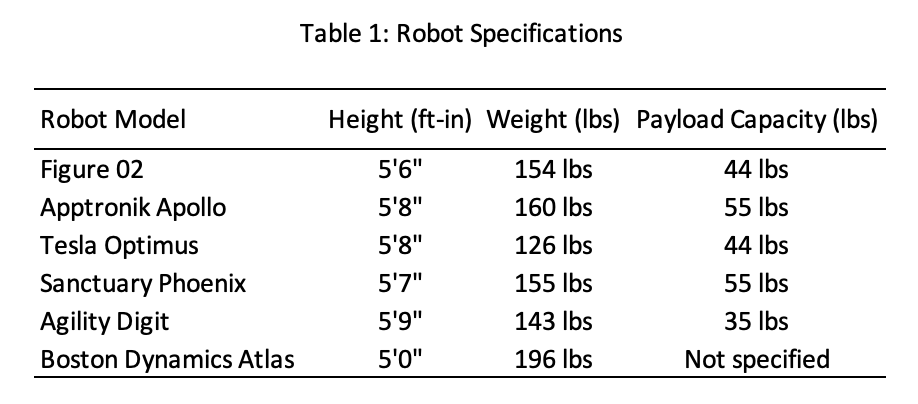How Many Robots?
Marc Andreesen: “I think there's a plausible argument—which Elon also believes—that robotics is going to be the biggest industry in the history of the planet. It's going to be gigantic. There will be billions, tens of billions, even hundreds of billions of robots of all shapes, sizes, and descriptions running around doing all kinds of things.” — (From the Reagan Foundation Economic Forum Simi Valley, California May 30, 2025)
Catch that? Billions of robots doing all sorts of things.
As the recently released report on AI from Mary Meeker says, things really are moving faster than we realize. Advances in AI are begetting ever faster development of the next big thing.
Robotics has advanced a ton in recent years, so I wanted to update my knowledge on what’s out there. Join me on a short tour of some of the main players.
Humanoid Robots
Some background.
The world of robotics is now enormous. Not in the billions yet, but still big. The International Federation of Robotics claims 3.9 million robots were in use worldwide by 2022. That is all robot types not just the human-like robots we see from Tesla and Apptronik (these humanoid bots are a very small part of the pie). Much more common are the robotic arms we see in auto and electronics manufacturing.

Let’s take a look at some of the leading players in the world of human-like, humanoid robots. Because of the immense complexity of a humanoid, versus say a single-purpose, fixed industrial robot, this field is still just getting off the ground.
The Big Players
Some of the top makers of human-like robots include Tesla, Apptronik, Sanctuary AI, Figure AI, Agility Robotics and Boston Dynamics.
Tesla
Tesla made a big splash in October 2024 with the “We Robot” event in Los Angeles. The company unleashed both a robotaxi and the humanoid Optimus robot at the same time. (By the way, for my local readers, Tesla plans to premier the robotaxi here in Austin in June 2025.)
Optimus is geared to “…performing unsafe, repetitive or boring tasks,” according to Tesla. I remember the buzz after the bot was introduced in the October event. People were gushing about how it was making drinks for them and talking with them.
Tesla standout feature: Learning by watching people. According to Milan Kovac, VP of Optimus, the bot learns from third-person videos on the internet of people doing tasks.
Note that much of what Optimus can currently do requires human operators (tele-operators) controlling things from afar. But the goal is to get to fully-autonomous operations without constant human intervention.
Given Elon’s enormous capacity to lead word changing technologies, I do have high hopes for what’s coming from Tesla.

Apptronik
In August 2023, Apptronik unveiled its Apollo robot. At roughly human size, 5 feet 8 inches tall and 160 pounds, the Apollo looks innocently human-like. It can lift and carry 55 pounds.
“People don’t want to do robotic, physically demanding work in tough conditions and they shouldn’t have to,” according to Apptronik.
The company is a spin-off of work started at The University of Texas and now has funding from Google among others. Among the bots I reviewed, Apollo appears the most human-like with eyes, head shape, arms and legs that are all vaguely human.
Apptronik Standout feature: Option to mount permanently to the floor with a static base (no legs), retaining the upper torso as-is.
See images of the Apptronik Apollo bot here.
Figure AI
This robot has figured (sorry, couldn’t resist) prominently alongside automaker BMW’s content and stories. It’s debatable how much the robots actually do at the BMW plant, but something is definitely happening.
Figure's robots will enable companies to increase productivity, reduce costs, and create a safer and more consistent environment," said Brett Adcock, Founder and CEO of Figure. "We look forward to working side-by-side with BMW Manufacturing to integrate AI and robotics into automotive production," said Adcock.
According to Forbes, some number of the robots are working at BMW but it seems the real life usage is limited to only a few bots and mostly at off hours.
On Figure’s website, they target three core use cases: physical labor, household and off-world! Now that’s my kind of forward thinking. Not even limited to this planet.
Figure standout feature: Collaboration with BMW manufacturing to use robots on the factory floor.
Sanctuary AI
According to the company, “Sanctuary AI is on a mission to create and deploy millions of industrial-grade humanoid robots to help address growing labor challenges.”
Of note, Sanctuary had an investment in another manufacturer on this list. In April Sanctuary announced it is selling its stake in Apptronik, the Texas robot maker, worth $125 million, according to The Logic.
Sanctuary standout feature: Hands. According to Sanctuary, their bot has “Industry-leading robotic hands with increased degrees of freedom (20 in total) that rival human hand dexterity and fine manipulation with proprietary haptic technology that mimics the sense of touch…” This should go a long way toward bringing robots the fine motor skills that humans have.
This video from Sanctuary blew me away. In it they describe something I had not thought about: we humans can’t always see everything we touch and interact with. Think of rummaging in your pocket for keys or digging into a drawer to grab a pen. We don’t necessarily see everything, we navigate by touch instead. This touch capability capability is one that Sanctuary is focused on.
Agility Robotics
“Meet DIGIT. The world’s first commercially deployed humanoid robot,” says Agility on their website. None other than Amazon has been testing Digit for warehouse operations, according to the retail and cloud giant. Amazon also has an investment stake in Agility through its Amazon Industrial Innovation Fund.
As far as I can tell, Agility has the only ready-made list of “skills” to choose from on their website. These include skills like tote palletizing, tote stacking and conveyor unloading.
The company discusses “Robots as a Service,” riffing on the ubiquitous SaaS models of software sales.
Agility standout feature: Amazon involvement. Given the enormous capability and innovative reputation of Amazon, I’d take note of Agility and expect it to have long legs.
Boston Dynamics
Boston Dynamics is an early, impressive innovator. They’ve been around since 1992 when Marc Raibert spun off from the MIT Leg Lab to form Boston Dynamics. Fast forward to 2025 and the company is now owned by Hyundai Motor Group and offers an array of robotic automation.
The Atlas humanoid robot is just one model from Boston Dynamics. Spot is popular as you’ve likely seen the bright yellow dog-like robot before. The company also sells more common fixed industrial robot arms as well.
Boston Dynamics standout feature: Long string of successful innovation over decades. Full range of commercially viable robots. Given their track record I have high hopes for Boston Dynamics.
Here is a summary of specifications for the robots we’ve looked at.
What’s Next
The holy grail of robotics is autonomy - the ability of a machine to proceed self-directed in hours (or more) of activity without ongoing human direction. Imagine a home domestic bot that starts in the morning and does all of its daily chores without you having to tell it what to do next.
We are still on the cusp of autonomous operation. Each of the companies offering humanoid bots is still limited, on the one hand by requiring tele-operators and on the other, severely limited to controlled, smaller areas of operation with limited freedom of movement.
A common theme among the six bots I covered is an emphasis on warehouse and logistics use cases. These workloads involve repetitive, potentially boring, dangerous tasks. What better place to start helping human operators. Elon loves to tout his bot in homey settings like the family kitchen, but those times are probably further out than the industrial applications.



